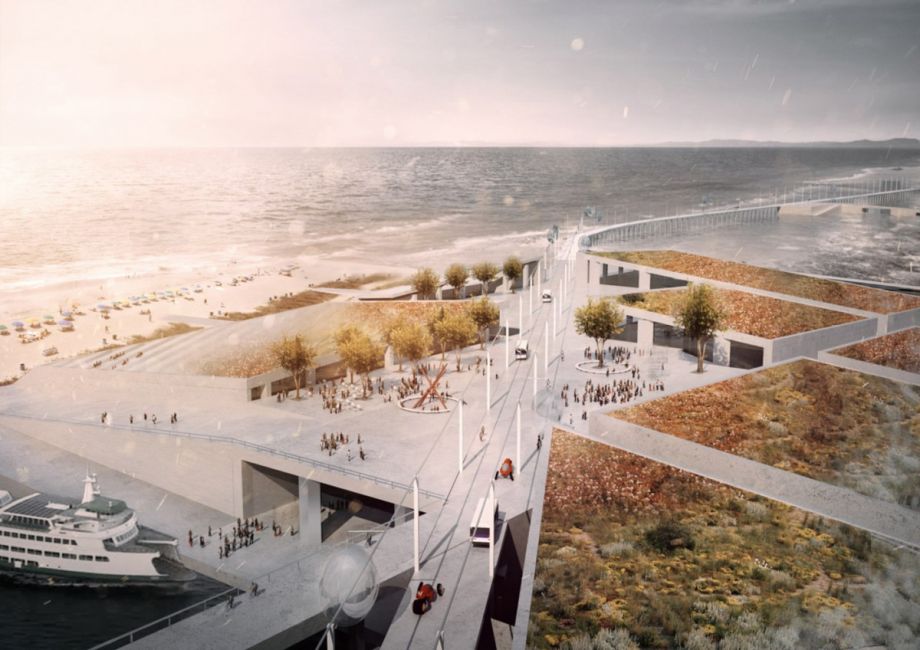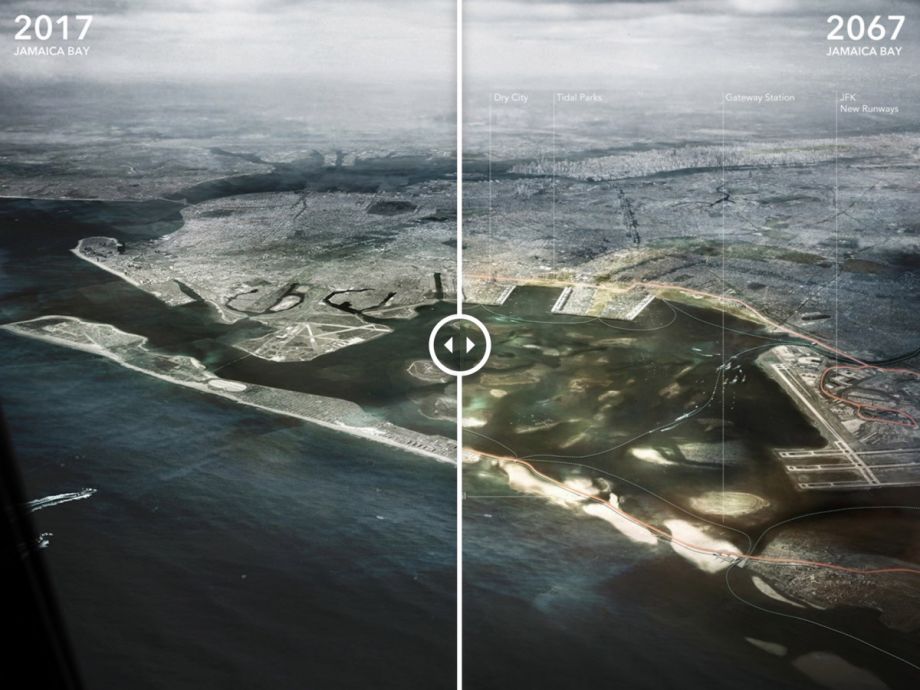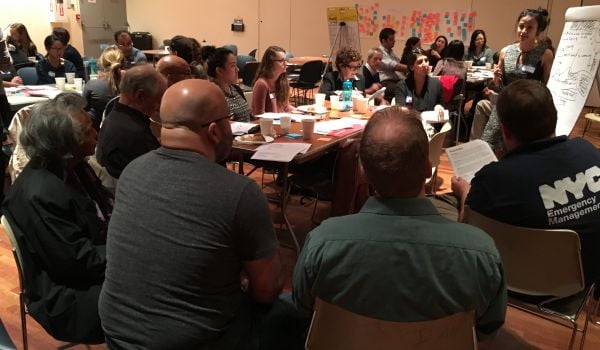Chatter about regional planning ebbs and flows in the urbanist world. But a group working that angle for nearly a century, the Regional Plan Association, has never stopped thinking in terms of New York, New Jersey and Connecticut. A new exhibit from the research and advocacy organization offers a look at a future in which that region has successfully adapted to sea level rise — and Mark Zuckerberg’s in the White House.
This particular vision is from one of the winners of RPA’s design competition “4C: Four Corridors: Foreseeing the Region of the Future.” Competing teams were asked to address four corridors: the forested Highlands, the inner ring suburbs, the route of a 24-mile rail line the RPA conceived to connect Brooklyn, the Bronx and Queens, and the stretch of coastline pinched between Long Island and the northeast tip of New Jersey known as the New York Bight. The winning team for the Bight is behind “President Zuckerberg.”
“I thought that the team that looked at the Bight came up with really interesting ideas,” says Rob Lane, a senior fellow for urban design at RPA, “about what the areas that are ultimately going to be under water might look like, how people can continue to feel some sense of ownership of them, even if they cannot literally occupy them.”
Teams working on each corridor had to think about how the region will grow in the coming years, along with challenges such as climate change. (See a full description of all winners here; the exhibit of their proposals runs in NYC through September 17.)
The Bight team, Rafi Segal Architecture and Urbanism and DLAND Studio, focused its work on three coastal areas: Jamaica Bay and Mastic Beach in New York and Sea Bright in New Jersey. In their vision, communities on the coast create conditions for denser development upland, so that residents forced to retreat from the water’s edge have a place to live in the same area. The coast itself is converted into a buffer zone, used for recreation, transit, aquaculture and energy production.
“One of the agendas of the RPA is to be kind of pro-development and pro-growth,” says Susannah Drake, founding principal of DLAND Studio. “So we were asked to look at strategies that imagined that the metropolitan area would continue to grow … and I think that’s an important jumping-off point, because it suggested that we had to be fairly aggressive with our strategies for making new buildings and new transportation and new opportunities.”
The coastal area of the city isn’t an ideal place to grow, says Rafi Segal, which made envisioning the future of the Bight doubly challenging. People think of retreat as being “cowardly,” Segal and Drake say; their goal was to focus on “receiving” residents on higher ground, turning the inevitable retreat into a positive.
“What we didn’t realize is that there were these really well-established corridors from the 1930s that existed that were underdeveloped and represented opportunity,” says Drake. “So we said, gosh, this is a place where we can actually build upon existing resources but also make brand-new development space that becomes an attractor for a population that’s living along the waterfront but also an attractor for, basically, new linear cities.”

The winning Bight team's plans for a “series of plazas, beaches, and public programs [that] form an intermodal station and recreational center built along the existing elevated rail of the Rockaways, Jamaica Bay 2050.”
In their vision, Jamaica Bay “protects its edges while doubling as New York’s new sunken central park.” Mastic Beach, a struggling Long Island village that disincorporated last year, is partially submerged by 2050, with a thriving community on higher ground and energy farming, and a few off-the-grid holdouts living amphibiously in the buffer. In this future, Sea Bright, New Jersey, loses a barrier island after “Hurricane Hermine” in 2023.
The team incorporated clever storytelling to convey its design ideas. That’s where the speculative political futurism with President Mark Zuckerberg establishing a universal basic income and New Jersey Governor Jon Bon Jovi comes in. They made postcards from the future, and there are video interviews with “residents” of Bight City.
Is this a dystopia? Drake and Segal say that in thinking through various scenarios, they tried to be as realistic as possible, to anticipate what the residents of the cities they envision might be living through. In a country that elected the world’s least creative real estate developer as president, it’s certainly plausible that the office could be held by a billionaire whose wealth is built on the surveillance of 2 billion Facebook users’ online habits. And on a planet threatened with increasing environmental calamities, it’s a guarantee that the future will have some dystopian qualities, as the present already does.
Still, speculative politics aside, the larger themes of the RPA competition shine through. Challenges that transcend political boundaries — like climate change or regional planning — need solutions that transcend political boundaries.
The design competition’s focus on four corridors reflects the RPA’s evolving vision of the region. Whereas the group initially viewed the metro area as a bull’s-eye, with everything feeding the all-powerful urban economic engine at the center, it now acknowledges the region as polycentric, says Lane.
“In most of the region you can’t really just talk anymore about cities and suburbs and country,” Lane says. “We have a whole slew of hybrid conditions that are really not one or the other, and they’re not going away. And they call for a set of solutions that are more hybrid solutions that talk about development and open space working together, development and water working together, and trying to figure out how to make mobility possible in those places.”

Jared Brey is Next City's housing correspondent, based in Philadelphia. He is a former staff writer at Philadelphia magazine and PlanPhilly, and his work has appeared in Columbia Journalism Review, Landscape Architecture Magazine, U.S. News & World Report, Philadelphia Weekly, and other publications.
Follow Jared .(JavaScript must be enabled to view this email address)
















